The Edible Pond and Bog Garden
The following list contains many plants, most of them either natives of Britain or naturalized here, that can be grown in ponds or boggy ground. They are all perennials and, unless stated otherwise, can be easily propagated by seed or by division in spring or autumn. The list shows that there is a tremendous potential for food production from ponds and boggy areas.
Many gardens already have ponds in them and, indeed, will probably contain several of the plants mentioned below. In other gardens ponds can be very easily set up (as long as you don't mind a bit of digging) by using plastic pond liners, pre-formed glass-fibre ponds, or concrete. Even a very small pond has great potential for food production and any pond adds significantly to the ability of a garden to support a wide range of wildlife. It is not intended to go into details of making ponds and establishing a water garden in this leaflet - contact us if you want details. However, most of the plants listed here are very easy to cultivate, indeed, with some of them the problem will be more one of trying to contain them as they are very vigorous, and you should find that your pond, once established, will require very little attention.
Just a couple of points that may be worth mentioning are:
- Ensure that your pond has at least one shallow side to enable creatures, especially amphibians, to get in and out easily;
- Ensure that it has several different levels (with at least one area more than two feet deep) to enable you to grow a variety of plants and to make sure that even in severe weather some of the water at the bottom of the pool is not frozen.
If your garden already contains an area of very wet soil that you've never been able to do much with then hopefully this leaflet will give you some ideas. It is fairly easy to create an area of boggy soil and perhaps the simplest methods are:
- If you have an old garden pond that keeps leaking then just fill it up with earth and use it as a bog garden.
- Excavate an area of soil to about one and a half feet, line it with plastic, puncture it in a few places and then replace the soil.
- Fill in the shallow edges of your pond with earth.
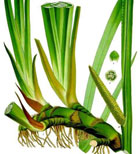 Acorus calamus - Sweet Flag: A native of Europe, naturalized in Britain, growing on the shallow edges of ponds and in most soils. The rhizomes, harvested in autumn or spring, are edible and can be used as a substitute for ginger, cinnamon or nutmeg - in the past the rhizomes were candied and used as a sweetmeat. The inner portion of young stems can be eaten raw and young leaves can be eaten cooked. Other virtues of this plant include its mature leaves, which are insect repellant, the lower stem and rhizome, which can be dried and used to scent clothes, cupboards etc, and an essential oil which can be extracted from the rhizome.
Acorus calamus - Sweet Flag: A native of Europe, naturalized in Britain, growing on the shallow edges of ponds and in most soils. The rhizomes, harvested in autumn or spring, are edible and can be used as a substitute for ginger, cinnamon or nutmeg - in the past the rhizomes were candied and used as a sweetmeat. The inner portion of young stems can be eaten raw and young leaves can be eaten cooked. Other virtues of this plant include its mature leaves, which are insect repellant, the lower stem and rhizome, which can be dried and used to scent clothes, cupboards etc, and an essential oil which can be extracted from the rhizome.
 Aponogeton distachyos - Cape Pondweed: Native of South Africa, this plant is often grown in ornamental ponds and is occasionally found naturalized in Britain. It does best in water from six inches to two feet deep and prefers a rich soil. The tubers are edible, as are the flowering spikes which can be used as a spinach substitute.
Aponogeton distachyos - Cape Pondweed: Native of South Africa, this plant is often grown in ornamental ponds and is occasionally found naturalized in Britain. It does best in water from six inches to two feet deep and prefers a rich soil. The tubers are edible, as are the flowering spikes which can be used as a spinach substitute.
 Beckmannia eruciformis: Native of Europe and Asia, this grass grows in wet meadows, swamps, marshes and very shallow water. The seed is edible, ground and used as a flour.
Beckmannia eruciformis: Native of Europe and Asia, this grass grows in wet meadows, swamps, marshes and very shallow water. The seed is edible, ground and used as a flour.
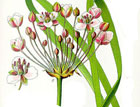 Butomus umbellatus - Flowering Rush: Native of Britain, it grows in moist soil or water up to one foot deep. The tubers, which contain over 50% starch, are edible when cooked. The seed is also edible.
Butomus umbellatus - Flowering Rush: Native of Britain, it grows in moist soil or water up to one foot deep. The tubers, which contain over 50% starch, are edible when cooked. The seed is also edible.
 Chrysosplenium alternifolium and C. oppositifolium - Golden Saxifrages: Natives of Britain, they grow in wet meadows, swamps etc, and prefer a shady position. The leaves are edible raw or cooked.
Chrysosplenium alternifolium and C. oppositifolium - Golden Saxifrages: Natives of Britain, they grow in wet meadows, swamps etc, and prefer a shady position. The leaves are edible raw or cooked.
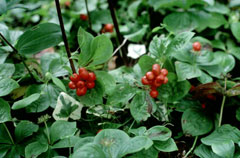 Cornus canadensis - Creeping Dogwood: Native of North America, this is a low-growing creeping plant. It does well on the drier edges of the bog garden, but it strongly dislikes chalky soils. The fruit is edible - it is said to have a pleasant though not very strong flavour.
Cornus canadensis - Creeping Dogwood: Native of North America, this is a low-growing creeping plant. It does well on the drier edges of the bog garden, but it strongly dislikes chalky soils. The fruit is edible - it is said to have a pleasant though not very strong flavour.
 Cyperus longus - Galingale: Native of Britain, it grows in ditches and marshy soils. The root is edible and it can be used as a spice.
Cyperus longus - Galingale: Native of Britain, it grows in ditches and marshy soils. The root is edible and it can be used as a spice.
 Glyceria fluitans - Float Grass: Native of Britain, it grows in shallow pond margins. The seed is sweet and is used in puddings or as a gruel.
Glyceria fluitans - Float Grass: Native of Britain, it grows in shallow pond margins. The seed is sweet and is used in puddings or as a gruel.
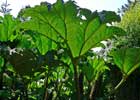 Gunnera tinctoria: Native of Chile, this plant looks like an overgrown rhubarb and, in sheltered positions and moist soils, the stem can be five feet tall and the leaf a yard or more across. Although they don't look tremendously appetizing, the leaf stalks are said to be edible. Probably best when young.
Gunnera tinctoria: Native of Chile, this plant looks like an overgrown rhubarb and, in sheltered positions and moist soils, the stem can be five feet tall and the leaf a yard or more across. Although they don't look tremendously appetizing, the leaf stalks are said to be edible. Probably best when young.
 Nasturtium officinale - Watercress: Native of Britain, this is the familiar salad plant for sale in greengrocers etc. It prefers growing in very shallow water (about two inches deep) but can also be found in marshy soils. It should be propagated by seed or by cuttings which will root easily and quickly in a container of water at any time of the growing season. As well as its leaves being edible, its seeds may be used as a mustard substitute.
Nasturtium officinale - Watercress: Native of Britain, this is the familiar salad plant for sale in greengrocers etc. It prefers growing in very shallow water (about two inches deep) but can also be found in marshy soils. It should be propagated by seed or by cuttings which will root easily and quickly in a container of water at any time of the growing season. As well as its leaves being edible, its seeds may be used as a mustard substitute.
 Nuphar lutea - Yellow Water Lily: Native of Britain, it grows in water between one and two feet deep, preferring a sunny position. The roots are edible either raw or cooked, the leaf stalks may also be eaten, and a drink can be made from the flowers. Two allied species from North America, N. advena and N. polysepala, are often grown in ornamental ponds and they can be used in similar ways. In addition the seeds are edible, being ground up and used as thickeners in soups etc. This would suggest that the seeds of N. lutea could also be used in this way, but we have not found any references to this.
Nuphar lutea - Yellow Water Lily: Native of Britain, it grows in water between one and two feet deep, preferring a sunny position. The roots are edible either raw or cooked, the leaf stalks may also be eaten, and a drink can be made from the flowers. Two allied species from North America, N. advena and N. polysepala, are often grown in ornamental ponds and they can be used in similar ways. In addition the seeds are edible, being ground up and used as thickeners in soups etc. This would suggest that the seeds of N. lutea could also be used in this way, but we have not found any references to this.
 Nymphaea alba - White Water Lily: Native of Britain, it grows in the deeper parts of the pond - about four feet of water should suit it well. It prefers a sunny position and a rich soil. Rootstocks that are several years old may be eaten - they contain about 40% starch. Roasted seeds may be used as a coffee substitute. A related species from North America, N. odorata, can also be found in ornamental ponds. Its young leaves and flower buds can be eaten cooked and young flowers can be eaten raw.
Nymphaea alba - White Water Lily: Native of Britain, it grows in the deeper parts of the pond - about four feet of water should suit it well. It prefers a sunny position and a rich soil. Rootstocks that are several years old may be eaten - they contain about 40% starch. Roasted seeds may be used as a coffee substitute. A related species from North America, N. odorata, can also be found in ornamental ponds. Its young leaves and flower buds can be eaten cooked and young flowers can be eaten raw.
 Peltandra sagittifolia (Peltandra alba) and P. virginica - White Arrow Arum and Green Arrow Arum: Natives of North America, they grow in shallow water near the pond edges. Their rhizomes are edible but they must be well cooked, since they are both poisonous raw.
Peltandra sagittifolia (Peltandra alba) and P. virginica - White Arrow Arum and Green Arrow Arum: Natives of North America, they grow in shallow water near the pond edges. Their rhizomes are edible but they must be well cooked, since they are both poisonous raw.
 Phragmites australis (Phragmites communis) - Common Reed: Native of Britain, growing in shallow waters and wet soils, this member of the grass family can grow up to 12 feet tall so it's not really one for the smaller garden, particularly as it is very invasive. However, it more than makes up for its antisocial tendencies with its quite impressive list of uses. The roots, which contain 5% sugar, are edible and can be dried, ground coarsely and used as a porridge. The young shoots can be eaten raw or cooked and the seed is also edible. If the stem is wounded it exudes a sugary substance which hardens upon exposure to the air. This can be eaten raw or roasted - indeed, the dried and ground inner stem can be moistened and then roasted to make a marshmallow substitute. Other virtues of this plant include the stems for thatching, basket making etc, and a light green dye that can be obtained from the stems.
Phragmites australis (Phragmites communis) - Common Reed: Native of Britain, growing in shallow waters and wet soils, this member of the grass family can grow up to 12 feet tall so it's not really one for the smaller garden, particularly as it is very invasive. However, it more than makes up for its antisocial tendencies with its quite impressive list of uses. The roots, which contain 5% sugar, are edible and can be dried, ground coarsely and used as a porridge. The young shoots can be eaten raw or cooked and the seed is also edible. If the stem is wounded it exudes a sugary substance which hardens upon exposure to the air. This can be eaten raw or roasted - indeed, the dried and ground inner stem can be moistened and then roasted to make a marshmallow substitute. Other virtues of this plant include the stems for thatching, basket making etc, and a light green dye that can be obtained from the stems.
 Pontederia cordata: Native of North America and occasionally naturalised in Britain, it grows in pond margins and marshy soils, though it is happiest in water about six inches to one foot deep. The seeds can be eaten raw or ground up and used as a flour substitute. Young leafstalks can be eaten raw or cooked.
Pontederia cordata: Native of North America and occasionally naturalised in Britain, it grows in pond margins and marshy soils, though it is happiest in water about six inches to one foot deep. The seeds can be eaten raw or ground up and used as a flour substitute. Young leafstalks can be eaten raw or cooked.
 Sagittaria sagittifolia - Arrow Head: Native of Britain, it grows in water up to one and a half feet deep. Its tuber can be cooked and eaten and is much cultivated in China for this purpose.
Sagittaria sagittifolia - Arrow Head: Native of Britain, it grows in water up to one and a half feet deep. Its tuber can be cooked and eaten and is much cultivated in China for this purpose.
 Samolus valerandi - Brookweed: Native of Britain, it grows in wet soil and shallow water. The young leaves can be eaten raw or cooked.
Samolus valerandi - Brookweed: Native of Britain, it grows in wet soil and shallow water. The young leaves can be eaten raw or cooked.
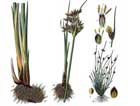 Scirpus lacustris - Bulrush: Native of Britain, it grows in bogs or shallow pond margins. The roots are edible and can be eaten raw or dried, ground and used as a flour. The young shoots in spring are also edible. The leaves can be used in weaving for making mats, chair seats etc.
Scirpus lacustris - Bulrush: Native of Britain, it grows in bogs or shallow pond margins. The roots are edible and can be eaten raw or dried, ground and used as a flour. The young shoots in spring are also edible. The leaves can be used in weaving for making mats, chair seats etc.
 Sparganium erectum - Bur-Reed: Native of Britain, it grows in marshes, ditches and shallow edges of ponds, requiring a rich soil if it is to do well. The tuber is edible.
Sparganium erectum - Bur-Reed: Native of Britain, it grows in marshes, ditches and shallow edges of ponds, requiring a rich soil if it is to do well. The tuber is edible.
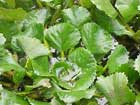 Trapa natans - Water Chestnut: Native of Asia and the Mediterranean, this plant is hardy in all but the coldest parts of Britain and it grows in water up to two feet deep. Its seed, which is about 50% starch, can be eaten raw, cooked, or dried and ground into flour. It is often cultivated for its seed in Asia. Propagation is by seed only.
Trapa natans - Water Chestnut: Native of Asia and the Mediterranean, this plant is hardy in all but the coldest parts of Britain and it grows in water up to two feet deep. Its seed, which is about 50% starch, can be eaten raw, cooked, or dried and ground into flour. It is often cultivated for its seed in Asia. Propagation is by seed only.
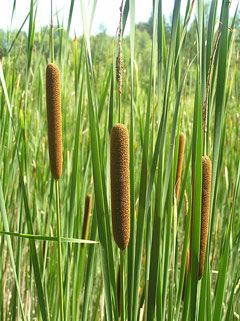 Typha angustifolia and T. latifolia - Small Reed Mace and Reed Mace: Natives of Britain, growing in pond margins, these plants are an absolute must for any self-respecting vegan 'self-sufficientist'. Make sure that you've got the room for them though because they are very invasive (especially T. latifolia) and will soon overrun most of your other plants if you don't keep an eye on them. Their catalogue of uses is most impressive and just why they are not used commercially is beyond us. Their rhizome is edible raw, cooked, or dried and ground into flour. Young shoots can be eaten raw or used as an asparagus substitute. The base of more mature stems can be eaten raw or cooked (but remove the outer covering). The seeds are edible and, when roasted, are said to have a pleasant, nutty flavour. An edible oil can be extracted from the seed. The pollen, which is a good source of protein, can be added to flour, and the young flowering spikes can be cooked and eaten. As if all that was not enough, the leaves can be used in weaving to make hats, mats etc, the hairs on the fruits can be used as a stuffing material for pillows etc, the stems are used in paper making and the dried flowers make a good insulating material. It's quite wonderful, isn't it?!
Typha angustifolia and T. latifolia - Small Reed Mace and Reed Mace: Natives of Britain, growing in pond margins, these plants are an absolute must for any self-respecting vegan 'self-sufficientist'. Make sure that you've got the room for them though because they are very invasive (especially T. latifolia) and will soon overrun most of your other plants if you don't keep an eye on them. Their catalogue of uses is most impressive and just why they are not used commercially is beyond us. Their rhizome is edible raw, cooked, or dried and ground into flour. Young shoots can be eaten raw or used as an asparagus substitute. The base of more mature stems can be eaten raw or cooked (but remove the outer covering). The seeds are edible and, when roasted, are said to have a pleasant, nutty flavour. An edible oil can be extracted from the seed. The pollen, which is a good source of protein, can be added to flour, and the young flowering spikes can be cooked and eaten. As if all that was not enough, the leaves can be used in weaving to make hats, mats etc, the hairs on the fruits can be used as a stuffing material for pillows etc, the stems are used in paper making and the dried flowers make a good insulating material. It's quite wonderful, isn't it?!
 Vaccinium palustre - Small Cranberry: Native of Britain, this is a prostrate shrub that grows on acid, boggy soils and strongly dislikes chalky soils. Propagation is by seed or by layering the stems in spring. The fruit is edible and is held by some to be the most delicious of our native wild fruits. A tea can be made from the dried leaves, a red dye is obtained from the fruits, and the juice of the fruit is a very effective cleaner for your family silver. A closely related shrub, V. macrocarpon, is native of North America where it is widely cultivated for its fruit. It too can be grown in the bog garden.
Vaccinium palustre - Small Cranberry: Native of Britain, this is a prostrate shrub that grows on acid, boggy soils and strongly dislikes chalky soils. Propagation is by seed or by layering the stems in spring. The fruit is edible and is held by some to be the most delicious of our native wild fruits. A tea can be made from the dried leaves, a red dye is obtained from the fruits, and the juice of the fruit is a very effective cleaner for your family silver. A closely related shrub, V. macrocarpon, is native of North America where it is widely cultivated for its fruit. It too can be grown in the bog garden.
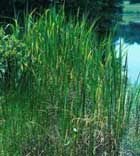 Zizania latifolia: Native of East Asia, this plant is much grown in Britain on the shallow margins of lakes. It is often cultivated as a food plant in Asia, it has edible rhizomes, young shoots and stem bases. The seed is also edible but, unfortunately, although it is perfectly hardy in Britain, it does not flower here, spreading instead by vegetative means. A close relative of this plant, Zizania aquatica, is the wild rice plant whose horrendously expensive seeds can be seen for sale in health food shops. The plant is an annual, native of North America, and, although it should be perfectly hardy here, we know of no source of viable seed in this country (seed in the shops has been heat-treated and does not germinate). If you can get hold of some viable seed then (apart from letting us have some!) you could give it a try in the shallow pond margins. It dislikes stagnant water and does best in a very slow- moving current.
Zizania latifolia: Native of East Asia, this plant is much grown in Britain on the shallow margins of lakes. It is often cultivated as a food plant in Asia, it has edible rhizomes, young shoots and stem bases. The seed is also edible but, unfortunately, although it is perfectly hardy in Britain, it does not flower here, spreading instead by vegetative means. A close relative of this plant, Zizania aquatica, is the wild rice plant whose horrendously expensive seeds can be seen for sale in health food shops. The plant is an annual, native of North America, and, although it should be perfectly hardy here, we know of no source of viable seed in this country (seed in the shops has been heat-treated and does not germinate). If you can get hold of some viable seed then (apart from letting us have some!) you could give it a try in the shallow pond margins. It dislikes stagnant water and does best in a very slow- moving current.
Database
The database has more details on these plants: Acorus calamus, Aponogeton distachyos, Beckmannia eruciformis, Butomus umbellatus, Chrysosplenium alternifolium, Chrysosplenium oppositifolium, Cornus canadensis, Cyperus longus, Glyceria fluitans, Gunnera tinctoria, Nasturtium officinale, Nuphar advena, Nuphar lutea, Nuphar polysepala, Nymphaea alba, Nymphaea odorata, Peltandra sagittifolia, Peltandra virginica, Phragmites australis, Pontederia cordata, Sagittaria sagittifolia, Samolus valerandi, Scirpus lacustris, Sparganium erectum, Trapa natans, Typha angustifolia, Vaccinium macrocarpon, Zizania aquatica, Zizania latifolia.